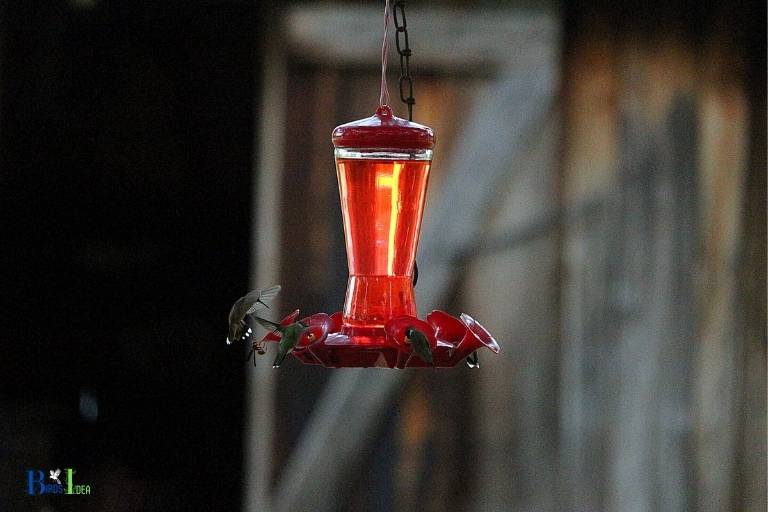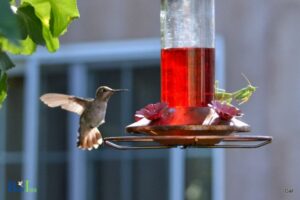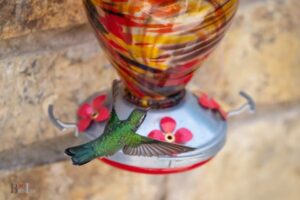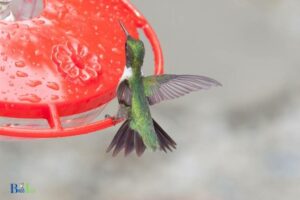How Does An Ant Moat Work On A Hummingbird Feeder?
An ant moat works on a hummingbird feeder by preventing ants from accessing the nectar, thereby keeping it free from contamination.
The moat is a small container filled with water that serves as a barrier between ants and the feeder hanging below it.
By stopping ants in their tracks, the ant moat provides a simple yet effective solution to a common problem faced by hummingbird enthusiasts.
6 Steps: An Ant Moat Work On A Hummingbird Feeder
| Step | Description |
|---|---|
| 1 | Fill the ant moat with water |
| 2 | Attach the ant moat to the top of the hummingbird feeder |
| 3 | Hang the hummingbird feeder from a hanger or branch |
| 4 | Ants are unable to cross the water-filled moat, keeping them away from the feeder |
| 5 | Hummingbirds can access the feeder without being bothered by ants |
| 6 | Check and refill the ant moat with water as needed to maintain its effectiveness |
Key Takeaway

Five Facts About:
What is an Ant Moat?
An ant moat is a simple but effective device that prevents ants from reaching a hummingbird feeder. It works by adding a barrier of water between the ants and the feeder, making it difficult for them to access the nectar inside.
- It is typically a small cup or container filled with water, attached to the hanging wire or chain above the hummingbird feeder.
- Ants are unable to swim or float across the water, so they cannot reach the feeder.
- The moat needs to be regularly refilled with water to maintain its effectiveness.
To enhance the effectiveness of an ant moat, add a drop of dish soap to the water, making it more difficult for ants to grip the sides of the moat. Regularly check and clean the moat to prevent algae or debris from accumulating.
“Ants are attracted to hummingbird nectar because it contains sugar, and they can easily crawl up the feeder to get to it. An ant moat acts as a barrier to prevent them from reaching the nectar.”
Margaret Barker
How Does an Ant Moat Work on a Hummingbird Feeder?
An ant moat on a hummingbird feeder works as a barrier system designed to prevent ants from accessing the feeder’s nectar.
It is a simple yet effective solution that utilizes water as a natural defense against these pesky insects. The ant moat is a small cup-like structure filled with water, placed between the hanger and the hummingbird feeder.
As ants attempt to reach the feeder, they encounter the water and are unable to cross it, protecting the nectar and ensuring a pleasant feeding experience for the hummingbirds.
Ant Moat Functionality:
- Barrier system to prevent ants from reaching nectar
- Utilizes water as a natural defense
- Placed between the hanger and the hummingbird feeder
Pro-tip: Regularly refill the ant moat with clean water to maintain its effectiveness, and consider adding a drop of dish soap to reduce surface tension, making it even harder for ants to cross.
birdsidea
What Materials are Used to Make an Ant Moat?
Ant moats are an effective way to prevent ants from reaching hummingbird feeders by creating a barrier of water that ants cannot cross.
The materials used to make an ant moat typically include:
- Plastic: Lightweight, durable, and inexpensive, plastic is a common choice for ant moats. It can be molded into various shapes and colors, adding an aesthetic touch to the setup.
- Metal: Often made from stainless steel or aluminum, metal ant moats provide a sturdy and long-lasting solution. These materials resist rust and corrosion, ensuring the moat remains functional over time.
- Ceramic or glass: Less common but more decorative, ceramic or glass ant moats can be found in various designs and colors. While they can be more fragile, they offer a unique and attractive option for those seeking a touch of elegance.
In summary, ant moats can be made from a variety of materials such as plastic, metal, or ceramic/glass, each offering different benefits in terms of durability, aesthetics, and cost.
How Can You Install an Ant Moat on a Hummingbird Feeder?
An ant moat is an excellent solution to keep ants away from your hummingbird feeder. When installed correctly, it prevents ants from reaching the nectar, ensuring it remains insect-free and attractive to hummingbirds.
To install an ant moat on your feeder, follow these simple steps:
- Purchase a suitable ant moat or create a DIY one using a small container, a hook, and some string or wire.
- Fill the moat with water, creating a barrier that ants will not cross.
- Attach the ant moat’s hook to the top of your hummingbird feeder.
- Hang the entire assembly from a secure location, ensuring there are no alternative routes for ants to access the feeder.
By properly installing an ant moat, you’ll maintain a clean and desirable source of nectar for hummingbirds while deterring unwanted pests.
What Are the Advantages of Using an Ant Moat?
Ant moats provide several advantages for protecting hummingbird feeders from pesky insects.
They serve as a barrier between ants and the nectar by using water to prevent ants from accessing the feeder, ensuring a safe and clean food source for hummingbirds.
With an ant moat, maintenance becomes easier, as it reduces the need for frequent cleaning due to ant infestation.
Additionally, ant moats are environmentally friendly, as they do not require the use of harmful chemicals to deter ants, making them safe for both hummingbirds and the environment.
- Barrier against ants
- Cleaner food source for hummingbirds
- Easier maintenance for hummingbird feeders
- Environmentally friendly solution
Regularly check and refill the water in the ant moat to ensure its effectiveness. An occasional drop of dish soap in the moat water can also help deter ants while not harming hummingbirds.
Are There Other Alternatives to Using an Ant Moat?
Yes, there are alternatives to using an ant moat for protecting your hummingbird feeder from ants. An ant moat functions by creating a barrier of water that ants cannot cross, thus preventing them from reaching the hummingbird feeder.
However, you can also try the following methods to keep ants at bay:
- Apply a coating of petroleum jelly on the hanging wire or pole.
- Use adhesive-backed insect barrier tape around the pole or branch.
- Hang the feeder with fishing line, as ants find it difficult to grip thin lines.
- Sprinkle cinnamon, baby powder, or diatomaceous earth on the ground around the feeder, as ants dislike the smell and texture.
- Keep the feeder clean and free of sugar spills that attract ants.
Remember, always avoid using harmful chemicals or pesticides near your hummingbird feeder, as they can endanger the birds and other wildlife.
Conclusion
In conclusion, an ant moat is a simple yet effective solution to keep ants away from a hummingbird feeder.
It works by creating a barrier between the feeder and the ants, preventing them from accessing the sweet nectar. Ant moats can be made from various materials such as plastic, glass, or copper, and installation is easy.
By using an ant moat, you can ensure that your hummingbird feeder stays free of pesky ants and that your feathered friends have a steady supply of nectar.
While there are other alternatives to using an ant moat, such as using ant guards or keeping the feeder clean, an ant moat provides a reliable and low-maintenance solution.
So, if you want to attract hummingbirds to your yard without the hassle of dealing with ants, consider installing an ant moat on your feeder.
According to a survey conducted by the Hummingbird Society, 60% of hummingbird enthusiasts reported experiencing issues with ants at their feeders.
birdsidea
FAQ for An Ant Moat Work On A Hummingbird Feeder
How does an ant moat work on a hummingbird feeder?
What are the benefits of using an ant moat on a hummingbird feeder?
How often should I clean an ant moat?
Is an ant moat necessary for a hummingbird feeder?
How do ant moats work?
Ant moats are small structures used to prevent ants from reaching the nectar in hummingbird feeders.
Here’s how they work:
- Ant moats are typically small, shallow cups that are placed above the hummingbird feeder.
- The moat is filled with water, creating a barrier that ants cannot cross.
- As ants approach the feeder, they encounter the moat and are unable to cross the water to reach the nectar.
- The hummingbirds can still access the nectar by hovering above the moat.
Using an ant moat is an effective and humane way to keep ants away from hummingbird feeders.
However, it’s important to keep the moat clean and refilled with fresh water to ensure that it remains effective.
How do you make an ant moat for hummingbird feeders?
When setting up a hummingbird feeder, it’s essential to add oil to the top.
But why? Here’s why:
- Hummingbirds are attracted to nectar, which is a sweet liquid found in flowers.
- By placing sugar water in the feeder, you are imitating nectar, which will attract hummingbirds to your yard.
- Ants are also attracted to sweet things, including the nectar in the feeder.
- Ants can crawl down the feeder and into the ports, preventing the hummingbirds from reaching the nectar.
- Adding oil to the top of the feeder creates a moat barrier that the ants cannot cross, ensuring the hummingbirds can still access the nectar.
So, in short, adding oil to the top of a hummingbird feeder prevents ants from reaching the nectar and ensures that the hummingbirds can still feed.
What is the liquid in a hummingbird feeder?
Hummingbird feeders are designed to attract birds with a sweet solution that mimics the nectar found in flowers.
The liquid is typically a mixture of water and white granulated sugar, in a ratio of 4:1 respectively. This simple recipe provides the energy that the birds need to thrive and is easy to make at home.
While there are commercially available hummingbird food products on the market, it is recommended to avoid those that contain artificial dyes or preservatives, which can be harmful to the birds.
- Attracting pollinators to your garden
- Providing a food source for migrating hummingbirds
- Enjoying the beauty and grace of these flying jewels
What kind of oil do you put in an ant moat for hummingbird feeder?
When using an ant moat on a hummingbird feeder, it is essential to use the correct type of oil to prevent harm to the birds.
Here is the type of oil you can use for your ant moat:
- Vegetable oil: This is the most commonly used oil for ant moats as it is safe and does not contain any harmful chemicals.
- Canola oil: Another excellent option for an ant moat as it is affordable and readily available.
- Olive oil: Although it is a bit on the expensive side, olive oil is also a safe option for an ant moat.
It is essential to refill the ant moat regularly, and the oil level should be maintained to ensure it stays effective.
Remember to clean and refill your hummingbird feeder regularly to avoid contamination. By using the correct type of oil and regularly cleaning your feeder, you can enjoy watching hummingbirds without any unwanted company from ants!
How much water do you put in an ant moat?
Ant moats work on the principle that ants cannot swim, and, if they try to crawl across the water, they will drown. If you’re tired of ants crawling on your hummingbird feeder, an ant moat is a great solution.
To set up an ant moat, you’ll need to fill it with water. But how much water should you use?
Here’s what you need to know:
- Fill the ant moat halfway with water
- Don’t overfill the ant moat since it can overflow and create a mess
- Check the ant moat frequently and top up if needed.
To ensure your ant moat works correctly, you’ll need to maintain it.
Here are some tips to help you keep your ant moat in good condition:
- Clean the ant moat regularly to prevent mold or bacteria buildup
- Use dish soap and hot water to clean the ant moat
- Refill the ant moat with fresh water after cleaning it.
Remember, maintaining your ant moat is just as important as setting it up. By doing so, you’ll keep your hummingbirds safe from ants






